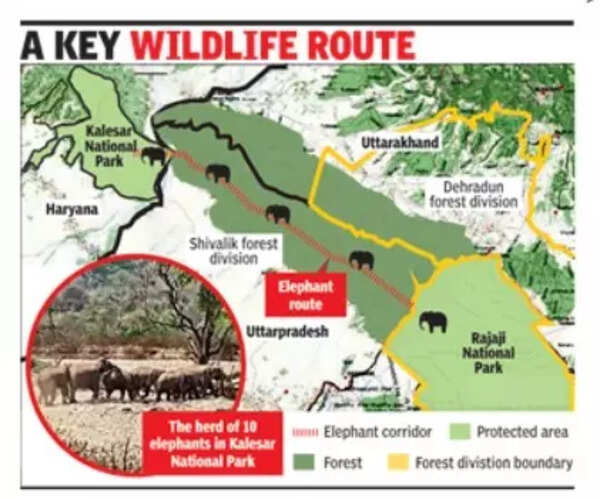Gurgaon: From foothills in Uttarakhand, a herd of 10 elephants and calves ambled through Uttar Pradesh’s forests and was spotted on Tuesday at the Kalesar National Park in Haryana’s Yamunanagar district.
Foresters said it wasn’t uncommon to see elephants trek to Kalesar from Uttarakhand’s Rajaji National Park, a distance of 100km by road, but this was the largest herd to have done so.
The herd’s movement, through the Shivalik division of UP to reach Kalesar, underscores the importance of protecting dense forest corridors that connect these parks, allowing wildlife to move across state boundaries without any interference in human settlements.
On Tuesday, the herd was at Gugga Fireline in the park.

“This is the third such sighting, but it is the biggest one so far. The presence of such a large elephant family in Kalesar highlights the park’s role as a critical habitat for wildlife in the region. Kalesar has similar vegetation to that of Uttarakhand, where the elephants travelled from,” said Vineet Garg, principal chief conservator of forests, Haryana.
The last sighting was in Jan this year, when two female elephants, a male and two calves were documented in Kalesar. Before that, it was in 2022 that a herd of three elephants was seen.
Kalesar National Park, which spans 11,570 acres along the UP-Haryana border, Kalesar Wildlife Sanctuary (13,209 acres) and Simbalbada or Sher Jung National Park in Himachal Pradesh are contiguous forests connected to the Rajaji reserve through a dense forest corridor that allows wild animals to move around.
The Kalesar park, enveloped in tropical dry deciduous forests, is home to leopards, barking deer, wild boars, sambhars and several bird species.
“This is a positive sign. We have also sighted a tiger from Rajaji park in Kalesar. A fully grown tiger was photographed by camera traps thrice at Kalesar National Park in 2023.
There is a wildlife corridor here, and it needs regular monitoring and conservation,” Garg said.
For now, the department is closely monitoring the herd’s movement to ensure they are safe.
“We are hopeful that the herd might stay here as we already have water for them inside the forest. Gugga Fireline, where they were spotted, is near the Sukhrav River,” said Lilu Ram, wildlife inspector in Kalesar.
Sumit Dookia, a wildlife biologist, said the corridor connecting Rajaji and Kalesar parks was well recognised. “Elephants, known for their remarkable communication skills, can trace their traditional corridors that are up to 50-70 years old. Therefore, it is common to see elephants traveling along the same paths. Tracing historical routes is crucial for wildlife, as it helps them find suitable habitats outside protected areas. This is especially important in India, where protected areas are smaller compared to those in Africa. Consequently, many areas cannot accommodate the entire animal population, necessitating migration. This movement is a positive sign for both the animals and the corridor,” he said.
Dr VB Mathur, former director of Wildlife Institute of India, said elephants often cover long distances in search of forage and water.
“This herd of elephants is likely to be traveling in search of water as the summer season is ongoing. It is likely that there may be some incidents of crop raiding by these elephants, for which the Haryana forest department needs to prepare,” Dr Mathur said.




